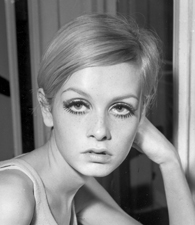By age 16, Twiggy was an international sensation, appearing on catwalks and magazine covers worldwide. She redefined the fashion world with her stick-thin body, popularizing the waif look over the more voluptuous pinups. When she retired from modeling at 20, Twiggy pursued a career in film and theater.
Twiggy’s Early Life
Twiggy was born Lesley Hornby in the London borough of Willesden on September 19, 1949. Her father William Norman Hornby was a builder and his wife Nellie Lydia Hornby was a factory worker for a printing firm. Many of Twiggy’s ancestors worked in farms, factories and industrial plants: a far cry from fashion runways.
Lesley herself preferred work to studying. She dropped out of high school to take a job at a beauty parlor, where she was discovered at age 15 by Justin de Villeneuve (né Nigel Davies). De Villeneuve got a hairdresser to give her a boyish cut, took some photos of her and transformed her into a fashion superstar by the time she was 16. It was de Villeneuve who gave Lesley her famous moniker, stating: “You’re like a twig. I’ll call you Twiggy.”
Twiggy’s most successful professional years occurred when she was a teenager: by 20, she retired from modeling and began to pursue a career as an actress. “I loved it,” Twiggy has said of her days as a teenage model. “It was like a dream come true, a fairy story. It was certainly better than going to school, which was the only other thing I’d ever done.”
Sources in this Story
- Nations’ Memorybank (via Internet Archive): Twiggy
- Time: The English Dream
- The New York Times: Twiggy, in Her ‘One and Only’ Phase
- IMDb: Biography for Twiggy
- YouTube: Twiggy modelling and dancing!
- National Portrait Gallery: Twiggy Lawson (née Lesley Hornby)
- Twiggy: The Official Site
- The Telegraph: Twiggy to unveil over-40s style bible
- The Daily Mail: Twiggy lashes out at ‘size zero’ actresses
- The Hollywood Reporter: ‘My Generation’: Film Review, Venice 2017
Twiggy’s Notable Accomplishments
Twiggy redefined the fashion industry in the 1960s, pioneering a trend that replaced curvy pinup girls with thin, more androgynous models. She was regularly on the cover of Vogue and Tatler magazines and became a marketing sensation after a mere four years of modeling. Mattel created a “Twiggy Barbie” in 1967 and lunch boxes, tights, sweaters, bags and false eyelashes were all branded with the Twiggy image.
Photos of Twiggy as well as videos of her dancing during the 1960s illustrate her pivotal role in defining the “flower power” generation. Twiggy’s image was so influential in determining popular culture of the era that London’s National Portrait Gallery owns 11 photographic portraits of her.
The Rest of the Story
Twiggy ended her modeling career with this statement, “You can’t be a clothes hanger for your entire life!” The young model parlayed her image into a series of acting roles, beginning with her 1971 film debut in director Ken Russell’s “The Boy Friend.” Twiggy won two Golden Globes for her performance and eventually took the part to the stage. Other films in her repertoire include the thriller “W” (1974), “The Blues Brothers” (1980) and “Madame Sousatzka” (1988). It was on the set of “Madame Sousatzka” that Twiggy met her second husband, Leigh Lawson. Her first husband, Michael Witney, had died of a heart attack in 1983.
Twiggy’s most successful television and stage work include her own variety series for the BBC as well as a lauded portrayal of Eliza Doolittle in Yorkshire TV’s production of “Pygmalion.” Returning to the stage in the 1980s, Twiggy was nominated for a Tony Award for her performance on Broadway in the Gershwin musical, “My One and Only.”
Twiggy later returned to the fashion and modeling world, serving briefly as a judge on “America’s Next Top Model.” She also wrote a book, “A Guide to Looking and Feeling Fabulous Over Forty.” The book deal came after Twiggy helped revive Marks & Spencer as the new face of the company’s ad campaign.
Returning to fashion also brought the pressures of the industry back to her attention. But in response to the anorexia-related deaths of two models in 2006, Twiggy blamed the film industry, not models, for the unrealistic expectations put on young women: “They go on about banning size zero, but I think Hollywood stars are the worst perpetrators. Most models are naturally long and gangly, while a lot of these young girls in Hollywood have gone on extreme diets…I was very skinny, but that was just my natural build.” She explained, “I always ate sensibly—being thin was in my genes.”
Twiggy remains active on social media platforms, such as Twitter. In 2017, she appeared in a film called “My Generation,” which examines the upheaval that came about to Britain’s class distinctions in the 1960s. Britain’s entertainment industry had been dominated by people from society’s upper classes until the 1960s, when people from the working classes, such as Twiggy, actor Michael Caine, and the members of The Beatles became international stars and cultural influences.
This article was originally written by Isabel Cowles; it was updated September 11, 2017.











